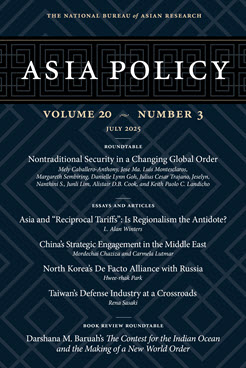Article in Asia Policy 20.3
Taiwan’s Defense Industry at a Crossroads
Challenges and Opportunities
This article examines Taiwan’s defense industry and finds that, despite recent efforts to enhance its industrial capabilities, Taiwan struggles to produce and procure a sufficient quantity of weaponry, ordnance, and support equipment due to historical, international, and domestic constraints.
EXECUTIVE SUMMARY
MAIN ARGUMENT
Taiwan’s defense industry is essential to its national security amid increasing pressure from China, but producing and procuring enough weaponry, ordnance, and support equipment more autonomously remains a persistent challenge. U.S. restrictions on technology transfers, aimed at maintaining regional stability and not provoking China, limit Taiwan’s access to advanced defense technologies. At the same time, China’s diplomatic and economic coercion discourages other states from engaging in arms sales or defense-related technology transfers to Taiwan. Domestically, Taiwan faces structural constraints, including partisan political divisions, a limited defense budget, a small domestic market, and an erosion of technical expertise following the completion of major defense projects. Despite these challenges, Taiwan has demonstrated strengths in asymmetric capabilities, such as missiles and unmanned technologies, as well as a competitive edge in dual-use innovation. However, Taiwan and its security partners must define the most critical defense capabilities and prioritize the most cost-efficient defense industrial strategy within existing resource constraints.
POLICY IMPLICATIONS
- Taiwan’s defense industry must align with its evolving defense strategy, prioritizing resilience, asymmetric capabilities, and integration with allied security frameworks. To sustain deterrence against China, Taiwan will need to strengthen domestic production in critical areas, such as surface-to-sea missiles and drones, while ensuring interoperability with U.S. and allied forces.
- Taiwan must enhance long-range precision-strike, asymmetric warfare, and sustainment capabilities to counter China’s military advantage. This includes investing in missiles, unmanned aerial vehicles, and mobile air defense and stockpiling essential supplies to ensure prolonged resistance in a conflict scenario.
- Given its resource scarcity, Taiwan should balance indigenous production, joint development, and imports to optimize its defense capabilities. Prioritizing domestic production for asymmetric systems, co-producing complex platforms, and relying on U.S. imports for high-tech assets will ensure cost-effectiveness and technological advancement.
Rena Sasaki is a PhD student at Johns Hopkins University’s School of Advanced International Studies (SAIS) and a fellow of the Pacific Forum’s Next Generation Young Leaders Program (United States).
About Asia Policy
Asia Policy is a peer-reviewed scholarly journal presenting policy-relevant academic research on the Asia-Pacific that draws clear and concise conclusions useful to today’s policymakers. Asia Policy is published quarterly in January, April, July, and October and accepts submissions on a rolling basis. Learn more


